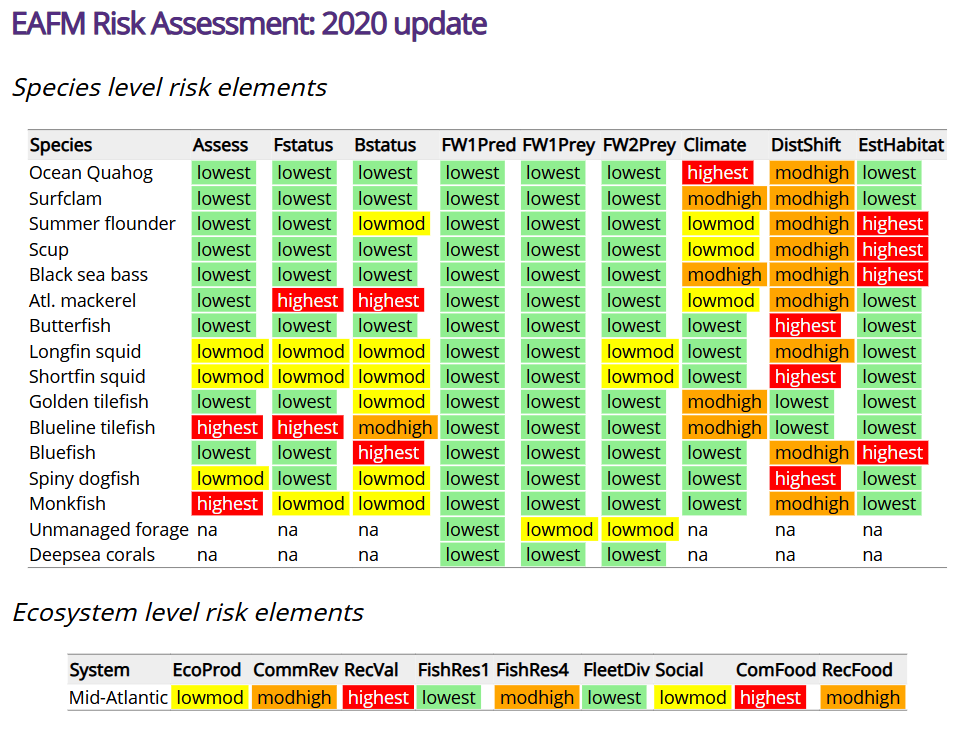In collaboration with Mid-Atlantic Fishery Management Council and stakeholders, NOAA scientists used the IEA approach to help incorporate key ecosystem components into management decision making. In August 2016, the Council approved the Ecosystem Approach to Fisheries Management Guidance Document, which formally adopted consideration of the IEA approach.

Stressors on the Northeast Marine Ecosystem
From New York to North Carolina, marine ecosystems along the Mid-Atlantic coast are experiencing increasingly complex stressors. Fishermen noticed shifting fish distributions. Demand for recreational fishing opportunities and other ocean uses has increased. Water quality and temperature changes are impacting species habitats. Demand for seafood is increasing. Regulations to protect marine mammals and other at-risk species are impacting fisheries.
The Mid-Atlantic Fishery Management Council manages fishery resources in the US waters from North Carolina to New York and is responsible for trying to address all of these issues.
Yet, managers have few processes in place to assess the interactions of these complex issues. Current management approaches do not directly address climate, habitat, or species interactions, and they address fleet interactions only to the extent that multiple fleets catch similar species. Social and economic interactions are only partially accounted for in the current fishery management process but are critical drivers of both fisheries dynamics and the benefits generated from our marine system, and they can connect species that may otherwise not be connected. This creates a need for a science and management approach that can help managers address ecosystem interactions.
An approach to address complex ecosystem interactions
In June 2015 the council convened a series of workshops to develop an Ecosystem Approach to Fisheries Management Plan. Scientists, managers, and stakeholders discussed potential strategies to consider species interactions and climate drivers in the stock assessment and management process. One workshop reviewed existing single species approaches as well as information and analytical tools available to address key species interactions. NOAA's Integrated Ecosystem Assessment (IEA) approach was adopted to help develop ecosystem science products for management.
In contrast to more conventional approaches to resource management, the IEA approach considers interactions among multiple components of the Mid-Atlantic marine ecosystem and recognizes that people are an integral part of the ecosystem. The IEA approach incorporates an understanding of the whole social and ecological system, not simply the individual components, into the management of marine ecosystems.
As part of the IEA approach, NOAA scientists gathered ecological, social, economic, and management indicators. Indicators measure the status and trends of key ecosystem components. Key indicators are then synthesized and presented annually to the council in the State of the Ecosystem report. The State of the Ecosystem report provides an overview of the current state of major system dynamics.
In August 2016, the Council approved the Ecosystem Approach to Fisheries Management Guidance Document. This guidance document formally adopted consideration of the IEA approach. The Council's stated goal for their Ecosystem Approach to Fisheries Management is "to manage for ecologically sustainable utilization of living marine resources while maintaining ecosystem productivity, structure, and function."
To accomplish this, the Council agreed to a framework that 1) prioritizes ecosystem interactions, 2) specifies key questions regarding high priority interactions, and 3) tailors appropriate analyses to address them. This would complement existing single stock assessment and essential fish habitat analyses by considering the whole system.
Prioritizing management efforts and assessing risk to the ecosystem
Guided by the IEA approach, NOAA scientists conducted an ecological risk assessment of the Mid-Atlantic marine ecosystem. An ecological risk assessment evaluates the potential extent and consequence of negative events occurring to the ecosystem. The Council intends to use results from this risk assessment to analyze the highest risk interactions for each species and identify strategies for addressing these risks. According to Brandon Muffley, a staff member for the Mid-Atlantic Fishery Management Council, "This approach has helped give the Council structure with specific steps to define what our management goals and objectives are, figure out how we can address those, and understand what that means for areas such as economics."
The Council selected what ecosystem components would be evaluated in this risk assessment at public meetings under the standard council stakeholder engagement processes of consensus-driven decision making. A group representing interests in fisheries and marine resources provided significant feedback through open public meetings and online access. Recommendations from public comments were fully discussed and integrated to the extent possible.

In October 2018, the Council used risk assessment results to focus on species with the largest number of high-risk rankings across all elements. The Council, scientists, and stakeholders will collaboratively develop a conceptual model to inform more in-depth modeling. There is potential for a management strategy evaluation, which would test alternative methods for achieving specific management objectives under uncertainty.
References:
- Gaichas, Sarah Kathleen, et al. "Implementing Ecosystem Approaches to Fishery Management: Risk Assessment in the US Mid-Atlantic." Frontiers in Marine Science 5 (2018): 442.
